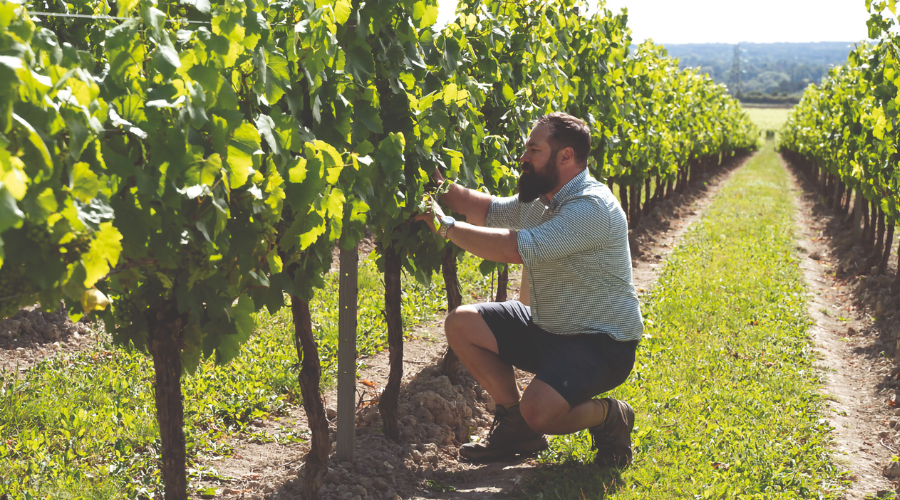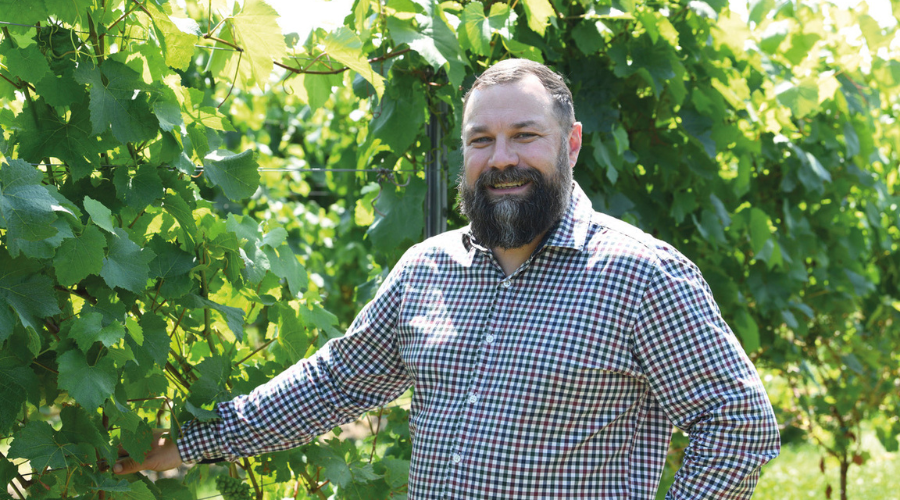Supporting vines from the soil up
19th April 2025
Viticulture consultant and vineyard owner, Luke Wolfe believes that good wine starts in the vine. He explains his approach to soil nutrition and its impact on vine health.

After graduating with a BSc in Viticulture and Oenology at Plumpton College, former financial and mortgage advisor Luke embarked on a period of freelance vineyard and winery work in New Zealand, California and France before he joined Chapel Down in the UK, heading up their vineyard operations and managing over 600 acres across Kent and East Sussex.
In 2018, 10 years after first meeting at Plumpton College, Luke and his good friend Clare Whitehead established their own vineyard, Whitewolfe Estates.
Situated in the Kits Coty region of Kent’s North Downs, the 10ha vineyard is planted exclusively with Chardonnay vines.
It was after co-founding Whitewolfe in 2019, that Luke decided to set up Agro-Pro Ltd, specialising in cool climate viticulture and working with large and boutique producers to improve their vineyard efficiency and maximise vineyard potential.
Luke explains: “Being a vineyard owner allows me to understand the emotional connection in establishing a vineyard and nurturing it to maturity, and at the end of the day, I practise what I preach.
“With the consultancy side of my business, much of my day is spent problem solving.
A significant amount of my work is based around 8–12 year-old vineyards which aren’t performing as hoped – and I would say that 90% of the time, the soil is the root cause – in particular, lack of soil nutrition.”
Smart Feed system
Luke has been working with Ross Barclay-Beuthin, founder of CloudAgro, for a number of years and has been heavily involved in the development of CloudAgro’s Smart Feed system during this time.
Smart Feed is a diagnostic and prescriptive system, designed to assess what a vine requires, and advise how to feed the soil accordingly.
Luke uses the Smart Feed system in his own vineyard and also when working with his clients to diagnose soil issues, and formulate a plan to boost the nutrition when and where it’s needed.
“In my experience, there can be a tendency for growers to load up the nutrients when first planting a vineyard, but then less and less nutrition might be put back into the soil over the next few years.
So I can usually see a pattern where, after 8–10 years, the vines seem to start going backwards in terms of vigour and yield,” comments Luke.
“It’s vital to keep a consistent level of nutrition and organic matter in the soil, as when the vines are put under pressure, like they were in the drought conditions of 2022, they will be more
able to withstand it.”
Alongside the Smart Feed system, CloudAgro produces a pelleted soil conditioning product called Futuregro.
This is based on detailed trials Ross carried out which assessed the impact of lucerne and chicken manure on soil health.
Futuregro contains a natural source of slow-release nitrogen, and a pre-composted fertiliser which actively improves the soil on application.
Having built up his soil health to a point where the organic matter is at 5.5%, in his own vineyard Luke now primarily uses Futuregro twice per year, in spring and autumn, using the product to top the SOM levels back up.

Fix problems before they arise
Luke is keen to point out that it’s important to support new vines, not just those which have begun cropping, and stresses that the aim is to continually improve the health of the soil and subsequently the vines.
“I’ve used artificial fertilisers and foliar feeds, but for me, with foliar feeds you’re just trying to treat a visible problem that has already had an impact – the time to boost the health of the vine is before the canopy has formed and the yield has set.
If you rely on foliar feeds to address nutrient deficiencies, you’ve already missed the boat.”
Just like standard chicken manure, Futuregro breaks down quickly and it is made readily available to the plant, but it’s actually quite a slow-release product.
Luke explains: “In the spring, it breaks down in the soil, where it is mineralised by the microbes and then is ready in a bioavailable format for the vine as and when it needs it.”
But, says Luke, it’s not just the vine which benefits from Futuregro and the Smart Feed system. “Every stage of the vine growth is impacted.
The growth is good, the fruit is bigger, better, stronger – you rarely see thin skins that are prone to splitting, because the vine is in balance.
“The main benefit of Smart Feed, particularly for someone like me who is working across multiple sites, is that you have access to so much specific data, and you can ensure it is relevant to the soil type and other factors on that particular site.
In my opinion, the RB209 is not fit for purpose for grapevines – the advice is based on strawberries and hops, and doesn’t take into account the very unique nutrient signature of vines.
Plus, even beyond that, each soil type also has its own challenges which need to be accounted for, such as pH.
“For me, the key message for me is that to get the best out of your vines, you need to research and learn about vine nutrition, or invest in the time and skills of someone who knows about it, because I’ve seen too many failing vineyards because they haven’t focused enough on their soil.
You have to start with the basics from the ground up. If you don’t look after your soil, at the end of the day it’s like building your dream house without laying the foundations properly – it will look good briefly, but as soon as it comes under pressure, it will all come crumbling down.”
Read more vine news.
